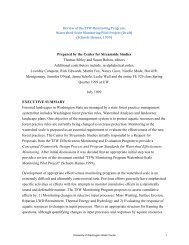Copyright 2012 Aileen M. Echiverri-Cohen - University of Washington
Copyright 2012 Aileen M. Echiverri-Cohen - University of Washington
Copyright 2012 Aileen M. Echiverri-Cohen - University of Washington
Create successful ePaper yourself
Turn your PDF publications into a flip-book with our unique Google optimized e-Paper software.
marginally predicted PPI for 30 ms, F(1, 32.14) = 3.62, p = .07, d = 0.67; B = -34.45, SE =<br />
16.69, t(30.26) = -2.06, p = .05), but not for 60 ms or 120 ms, providing some support, at a trend<br />
level, for a decline in automatic PPI inhibitory processes from pre-to post-treatment, regardless<br />
<strong>of</strong> treatment modality. There were no strong presences <strong>of</strong> treatment modality x time interactions.<br />
Taken together, accuracy on lags 3-5 in AB, but not percent inhibition for PPI, increased<br />
from pre- to post-treatment.<br />
Does Inhibition Change with Successful Treatment over Time (pre-treatment, post-treatment)?<br />
To examine the second a priori hypothesis examining clinical responder status, defined as<br />
change in pre-treatment interviewer-rated PTSD severity (PSS-I) to post-treatment, models were<br />
fit for each <strong>of</strong> the lags in AB (Lags 1, 2, 3, 4, and 5) and short lead intervals <strong>of</strong> PPI (30 ms, 60<br />
ms, 120 ms) as the dependent variables, with treatment response, time (pre-treatment, post-<br />
treatment), treatment response x time interaction.<br />
Attentional Blink. Similar to the previous models, the parsimonious random effect<br />
structure was when the intercept was allowed to randomly vary for treatment response and time<br />
and AB, Lag 2: var(u0j) = .02, χ 2 (1) = -20.06, p < .05, Lag 3: var(u0j) = .03, χ 2 (1) = -61.5, p <<br />
.05, Lag 4: var(u0j) = .01, χ 2 (1) = -108.78, p < .05, Lag 5: var(u0j) = .01, χ 2 (1) = -115.87, p < .05.<br />
Consistent with the analysis above, time significantly predicted AB for lags 3, 4, and 5 (Lag 3:<br />
F(1, 33.58) = 6.2, p < .05, d = 0.86; B = .04, SE = .02, t(33.58) = 2.49, p < .05; Lag 4: F(1, 35.2)<br />
= 7.45, p < .05, d = 0.92; B = .04, SE = .01, t(35.2) = 2.73, p < .05, Lag 5: F(1, 36.84) = 5.28, p <<br />
.05, d = 0.76, B = .04, SE = .01, t(36.84) = 2.30, p < .05), such that regardless <strong>of</strong> treatment<br />
response, accuracy on lags 3-5 increased from pre- to post-treatment. In contrast, there were no<br />
significant effects <strong>of</strong> treatment response or response x time interactions.<br />
36
















